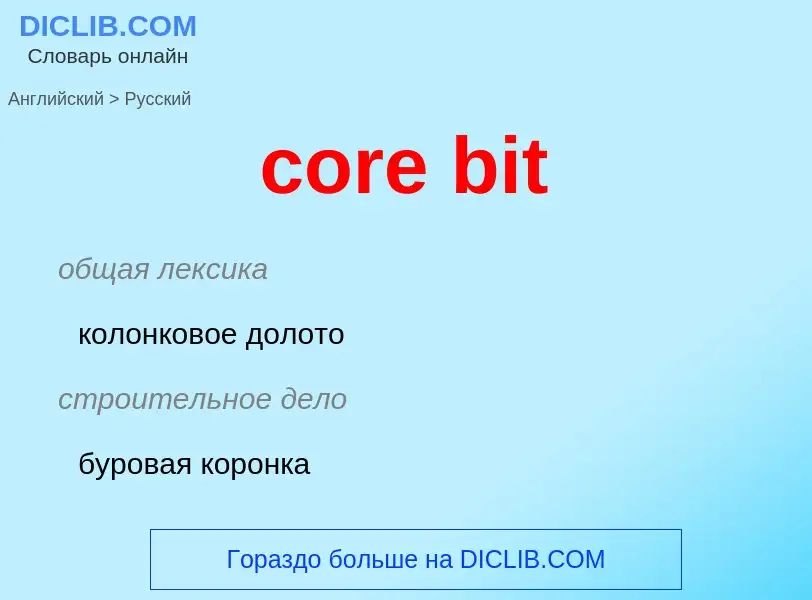Перевод и анализ слов искусственным интеллектом ChatGPT
На этой странице Вы можете получить подробный анализ слова или словосочетания, произведенный с помощью лучшей на сегодняшний день технологии искусственного интеллекта:
- как употребляется слово
- частота употребления
- используется оно чаще в устной или письменной речи
- варианты перевода слова
- примеры употребления (несколько фраз с переводом)
- этимология
core bit - перевод на русский
общая лексика
колонковое долото
строительное дело
буровая коронка
нефтегазовая промышленность
колонковое долото, колонковый бур
колонковое буровое долото
наконечник колонкового долота
строительное дело
колонковый бур
грунтонос
нефтегазовая промышленность
станок для колонкового бурения
['kɔ:driliŋ]
добыча полезных ископаемых
колонковое бурение
строительное дело
бурение с отбором керна
нефтегазовая промышленность
структурное бурение
нефтегазовая промышленность
буровой керн
образец породы (взятый при канатном бурении)
геологическая колонка
разрез (пересечённых скважиной пород)
['kɔ:'mem(ə)ri]
общая лексика
ЗУ на магнитных сердечниках
тип ОЗУ, использовавшийся в ЭВМ второго поколения (конец 50-х, начало 60-х годов), вытеснен полупроводниковой памятью. Магнитный сердечник можно намагничивать в одном из двух направлений. Затем направление магнитного поля можно определять по его воздействию на электрический ток, проходящий через центр сердечника
вычислительная техника
запоминающее устройство ЭВМ на (магнитных) сердечниках
Смотрите также
общая лексика
насквозь
Википедия

A modern core drill is a drill specifically designed to remove a cylinder of material, much like a hole saw. The material left inside the drill bit is referred to as the core.
Core drills used in metal are called annular cutters. Core drills used for concrete and hard rock generally use industrial diamond grit as the abrasive material and may be electrical, pneumatic or hydraulic powered. Core drills are commonly water cooled, and the water also carries away the fine waste as a slurry. For drilling masonry, carbide core drills can be used, but diamond is more successful when cutting through rebar.
The earliest core drills were those used by the ancient Egyptians, invented in 3000 BC. Core drills are used for many applications, either where the core needs to be preserved (the drilling apparatus used in obtaining a core sample is often referred to as a corer), or where drilling can be done more rapidly since much less material needs to be removed than with a standard bit. This is the reason that diamond-tipped core drills are commonly used in construction to create holes for pipes, manholes, and other large-diameter penetrations in concrete or stone.
Core drills are used frequently in mineral exploration where the coring may be several hundred to several thousand feet in length. The core samples are recovered and examined by geologists for mineral percentages and stratigraphic contact points. This gives exploration companies the information necessary to begin or abandon mining operations in a particular area.
Before the start of World War Two, Branner Newsom, a California mining engineer, invented a core drill that could take out large diameter cores up to 16 feet in length for mining shafts. This type of core drill is no longer in use as modern drill technology allows standard drilling to accomplish the same at a much cheaper cost.
Core drills come with several power choices including electric, pneumatic, and hydraulic (all of which require power sources, such as a generator).



![A 10.8×10.8 cm plane of magnetic core memory with 64 x 64 bits (4 Kb), as used in a [[CDC 6600]]. Inset shows ''word line'' architecture with two wires per bit A 10.8×10.8 cm plane of magnetic core memory with 64 x 64 bits (4 Kb), as used in a [[CDC 6600]]. Inset shows ''word line'' architecture with two wires per bit](https://commons.wikimedia.org/wiki/Special:FilePath/Ferrite core memory.jpg?width=200)




![This [[microSDHC]] card holds 8 billion bytes (8 GB). It rests on a section of magnetic-core memory that uses 64 cores to hold eight bytes. The microSDHC card holds over one billion times more bytes in much less physical space. This [[microSDHC]] card holds 8 billion bytes (8 GB). It rests on a section of magnetic-core memory that uses 64 cores to hold eight bytes. The microSDHC card holds over one billion times more bytes in much less physical space.](https://commons.wikimedia.org/wiki/Special:FilePath/8 bytes vs. 8Gbytes.jpg?width=200)
![US quarter]] for scale US quarter]] for scale](https://commons.wikimedia.org/wiki/Special:FilePath/Magnetic-core memory, 18x24 bits.jpg?width=200)

